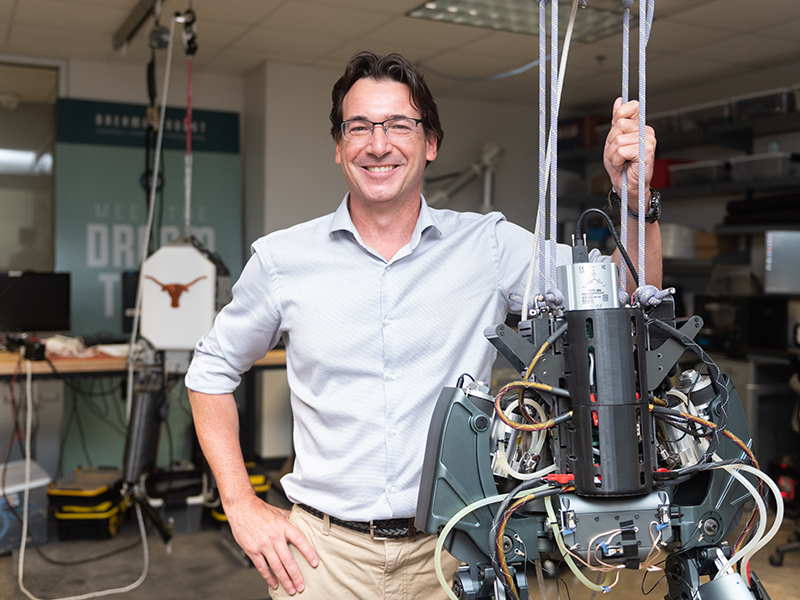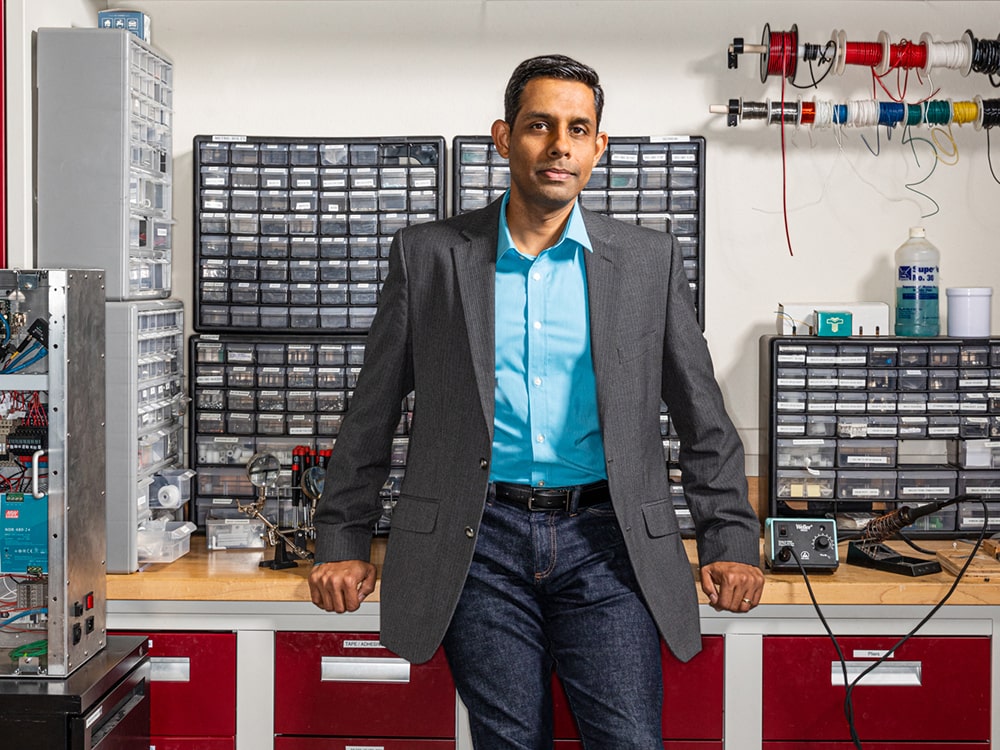
Researchers in the Department of Mechanical Engineering at the Cockrell School of Engineering are developing human-centered robotic technologies, such as robot hands and mobile robots, that will one day improve health care, ensure human safety and make manufacturing more efficient.
Assistant professor Luis Sentis’ Human Centered Robotics Lab has made significant strides in developing a human-friendly mobile robot, called Dreamer, which will one day be able to assist humans in everything from city maintenance to manufacturing. A Hollywood movie director unexpectedly called on Sentis this summer to feature Dreamer in “Transformers 4.”
In the ReNeu Robotics Lab, assistant professor Ashish Deshpande is working on various robotics technologies to improve physical rehabilitation for therapists and patients. Additionally, the lab is advancing a prosthetic robotic hand with human-like fingers, muscles and tendons. When finished, the robotic prosthetic should perform human functions such as holding and applying pressure.
Here’s a closer look at the striking research happening inside these two labs:
The Human Centered Robotics Lab
This summer, Dreamer, a robot with a bright cartoon-like face that resides in the Department of Mechanical Engineering, received its first set of wheels and made its acting debut in a major Hollywood film.
Three years ago, Luis Sentis, assistant professor at the Cockrell School of Engineering, established The Human Centered Robotics Lab at the Cockrell School to develop so-called humanoid robots, such as Dreamer, to interact safely with humans, perform tasks with flexibility and precision and to go where it’s too dangerous for humans to go. Indeed, robot safety among humans is a critical area now, as robots expand into industrial and field applications such as flexible manufacturing and search and rescue, according to robotics experts.

Luis Sentis, assistant professor in the Cockrell School of Engineering’s Department of Mechanical Engineering
Sentis and his students’ latest study on Dreamer, which had its wheel base and upper body combined in the last few months, will be published in the Journal of Autonomous Robots this fall.
For several years, the lab has developed Dreamer’s software and hardware, thoughtfully giving the robot useful features and capabilities. Today, the robot has wheels to give it mobility, hands with fingers for flexibility of motion, and human-like features, such as large, expressive eyes to communicate better with people.
Dreamer’s animated exterior attracted Hollywood director Michael Bay, which tapped the robot to appear in the fourth installation of the “Transformers” movie franchise. In the film, Dreamer may share as many as 30 seconds of screen time with actor Mark Wahlberg. The movie, which was shot in Elgin, Texas, will be out next summer.
Off camera, Dreamer is a state-of-the-art example of a rough terrain humanoid robot, outfitted with brains (software), sensors, lasers and wheels that will one day allow it to traverse cities and outdoor environments with relative ease. If all goes as planned, robots such as Dreamer could help clean streets, extinguish dangerous chemical fires or deliver life-saving medical care.
In addition to Dreamer, the lab has been part of a large team that is building a robot for NASA’s DARPA Robotics Challenge — a competition in which six teams design a high-functioning humanoid robot, dubbed Valkyrie. This summer, Sentis and four of his researchers spent half a week every week at NASA designing and controlling the humanoid, which is made up of dexterous hands, flexible limbs, sensors, safety systems and cameras. The team’s robot passed qualifications in June and is headed to the competition’s first round in December.
One of the major challenges for Valkyrie and Dreamer is self-regulated mobility.
“You need to use your cameras (on board the robot), your sensors and lasers to perceive and respond to the environment,” Sentis said. “The goal is to go outdoors and adapt to the environment and task. Right now, robots can’t go into a place where there are obstacles or debris. We are trying to solve this problem.”
Sentis’ solution is to develop whole-body robotic controls that provide safe human interaction.
“Professor Sentis is a leader in developing safe robot systems that can operate around humans,” said Mike Stilman, an assistant professor in robotics and intelligent machines at Georgia Institute of Technology. “His mobile robots can bump into walls, and even people, safely while still achieving their tasks. Furthermore, his approach to whole-body compliant control allows Dreamer to safely perform manipulation in close proximity with humans.”
The team is testing Dreamer’s ability to transition smoothly between flat and sloped flooring in different terrains and to avoid potential collisions with people and objects. Eventually, the researchers will program Dreamer to open doors and maneuver through tight spaces.
“Sentis is at the front lines of developing the theory and algorithms that will make safe motion a reality,” Stilman added.
One of Dreamer’s biggest successes so far is its wheel-mounted base, which was designed by high school students and UT Austin undergraduates. Sentis could have purchased a base, but he believed it was an important hands-on learning project.
“The current base has much better mechanics and flexibility,” Sentis said. “I could have purchased a base, but I wanted to educate as many people as possible.”
ReNeu (Rehabilitation and Neuromuscular) Robotics Lab
View a photo slideshow from the ReNeu Robotics Lab
After injuring his hand in a sports accident and going through long and painful physical rehabilitation, Ashish Deshpande, a mechanical engineering assistant professor in the Cockrell School of Engineering, came to appreciate the challenges of physical therapy. He also knew that he had found a health care problem that could benefit from an engineering solution.

Ashish Deshpande, assistant professor in the Cockrell School of Engineering’s Department of Mechanical Engineering
Robotics for rehabilitation is an emerging field, and currently only a few such devices exist. Deshpande and his team believe they can address the need for robotic devices that interact safely with patients and have the functionalities that therapists need.
“Physical therapy is labor-intensive, highly repetitive and costly. There is an opportunity for robots to assist, not replace, therapists. With robots we may be able to ease the burden on the caregivers and make therapy more available,” Deshpande said. “If you look at statistics, it’s very clear that we are going to need help in the medical field in terms of aging populations with physical and neurological disorders who will need physical therapy.”
Two years ago, Deshpande established the ReNeu Robotics Lab in the Department of Mechanical of Engineering to apply robotics technologies to the area of rehabilitation and prosthetics. Deshpande and his team of graduate and undergraduate students are developing health-related robotic technologies that are functional and human-friendly.
While it’s a long road from a design to a prototype to a product, the lab is making huge strides on three health-related robotics devices: a rehabilitation robotic hand, an upper-body rehabilitation exoskeleton and a human-like prosthetic robotic hand. These three projects have attracted more than $1.3 million in funding from the National Science Foundation and NASA. Deshpande’s project on the development of a prosthetic hand also earned him the NSF’s prestigious CAREER award in 2011.

Utilizing hand biomechanics and robot controls, the team’s prosthetic hand has human-like fingers, with mechanical muscles and tendons that will have the ability to hold and manipulate objects just like a human hand. At this stage, Deshpande and his team are focused on developing flexible, tendon-controlled joints, as well as the software to control the hand through visual and sensory signals. Ultimately, they hope to build a robotic hand that will closely mimic human neuromuscular behavior.
“We’ve gone further than anyone else in terms of human-like mechanical features and neuromuscular controls. Our goal is to spur the development of next-generation prosthetic hands,” Deshpande said.
Likewise, the team’s rehabilitation robotics for the hand and upper-body are also going far beyond any comparable devices. In rehabilitation, robotic devices can deliver repetitive therapeutic exercises and programmable motions that make them ideal. The lab’s upper-body device could help deliver therapy to patients with spinal cord injuries, or those who have suffered strokes and have impaired muscle control.
The lab’s hand device is designed to enable greater movement. While other hand devices only offer position control for one or two joints, the team is building a device that provides more flexibility of motion and more precise force control or intensity of pressure for many joints.
With the robotic devices, physical therapists will be able to monitor patients’ progress precisely and keep patients more engaged.
“The robots we are building will move the patients safely and comfortably through their natural movements,” Deshpande said. “New therapy options will open up because you can assist as well as resist the patients’ movements, allowing the therapists to develop personalized therapy plans.”
